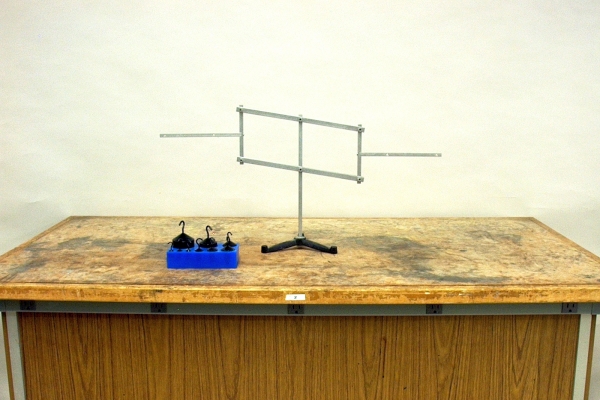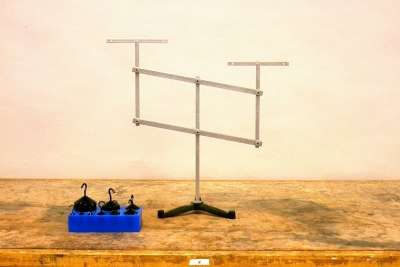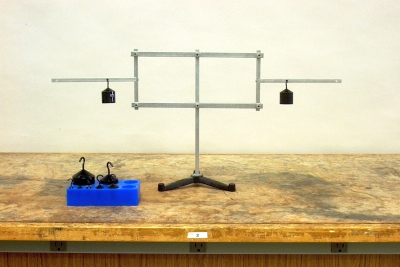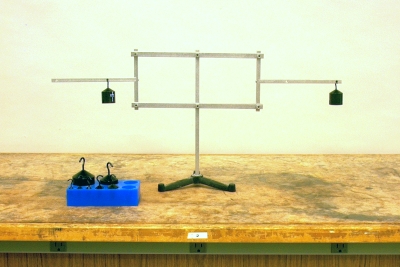
Two tee-shaped beams are connected to the ends of parallel horizontal beams, so that their long ends extend horizontally (in opposite directions). The two horizontal beams pivot about their centers, where they are supported by the stand, and the joints where the tee-shaped beams are connected, pivot as well. (The two beams are actually pairs of struts, which sandwich the stand and the tee-shaped beams.) As it sits, the balance will stay in whatever position you put it. If you hang two equal masses at equal distances from the center, they balance, and the stand stays at whatever position you put it (below left). Now hang them at different distances from the center, and the balance still stays however you put it (below right). If you hang two unequal masses, then the balance tips toward the side with the heavier mass.
At first glance, this demonstration resembles demonstration 32.03 -- Lever arm, in which two masses hang from a meter stick, on opposite sides of the fulcrum, and they balance if their moments – the products of their mass and their distance from the fulcrum – are equal. The balance in this demonstration has the interesting property that, as long as the masses are equal, no matter whether or not their distances from the center of the apparatus are equal, they balance. We can see why this is so, if we notice that on each side, the tee-shaped beam exerts a torque at its connection with each horizontal beam, and that these torques cancel to leave only a vertical downward force at the ends of the horizontal beams. To take the right side as an example, the tee exerts a clockwise torque about the top pivot (into the page). The bottom beam, which cannot move horizontally because it is fixed by the pivot at the center, opposes this torque by keeping the lower end of the tee from rotating toward the center. Similarly, the tee exerts a clockwise torque at this lower pivot, but tension in the upper beam, which is similarly fixed at the center pivot, opposes this torque by preventing the tee from swinging outward. These torques do depend on how far the mass is suspended from the ends of the central beams, but since they cancel, the only net force at the ends of the beams is the downward vertical force due to the weight of the tee and the weight of the hanging mass. The left side of the balance, of course, acts in exactly the same way, except that here the torques are counterclockwise (out of the page), and the tension and compression in the horizontal beams act in opposite directions to those on the right. The two horizontal beams pivot at the center, and so have equal arms on both sides. Equal masses, then, placed anywhere on the tees, have equal moments about the center, and exert equal and opposite torques about the centers of the horizontal beams. The downward force exerted by each is (wtee + wmass) cos θ, where θ is the angle the beams make with respect to horizontal.
This type of mechanism is at the heart of both dual-pan and single-pan balances. Each weighing pan has attached to it, within the base of the balance, a horizontal arm attached to a fixed pivot. The center of the pan sits directly above the pivot at the end of the main beam, whose other end connects either to a second, similarly mounted pan, or to a set of parallel rails, each with a different-size mass, and graduated in different increments, along which you slide the masses until their moments balance that of the object being weighed. If you don’t place the object exactly at the center of the weighing pan, this creates a torque about the pan’s support pivot. The arm attached underneath the pan, which connects it to the fixed pivot, opposes any such torque imposed on the pan, so that no matter where you place the object, the pan does not tilt, and its moment on the beam does not change. This is perhaps better illustrated if you attach the tees with the crosspiece on top, as in the photograph below:

This arrangement is similar to that in a dual-pan balance, although in such a balance, the bottom beam is normally not one solid piece, but rather two separate struts, each going from a pivot in the center to the connecting rod of its respective pan. It is probably also not as convenient for hanging masses as is the arrangement shown above.
As is evident from the photographs and text above, this balance, with equal masses on either side, sits at whatever angle you place it. It is in neutral equilibrium. Displacing it from its rest position does not change its potential energy, and so does not result in either a force that would push it back to its original position, or one that would push it further away. It merely sits at the new position. As also noted above, if you place unequal masses on the two sides of the balance, there is now a net torque on the horizontal beams, the balance is no longer in equilibrium, and the side with the heavier mass goes down. The pivot points in this balance are all on the centerline of the horizontal beams. Thus, tilting them (assuming the masses on both sides are equal) does not change the location of the center of mass of the system. If however, the center pivot of each horizontal beam were raised slightly above the centerline, then tilting the balance from horizontal to either side would raise the center of mass slightly. This would give rise to a torque that would restore the balance to its horizontal position. Thus, with equal masses on both sides, regardless of their distances from the center, the balance would always go to the horizontal position; it would be in stable equilibrium. (See demonstration 32.20 -- Neutral, stable and unstable equilibrium.)
References:
1) Chagnon, Paul. The Physics Teacher, 30 (4) 238 (1992).

